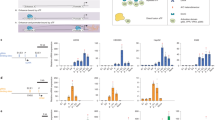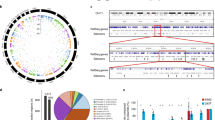Abstract
Insertional mutagenesis and genotoxicity, which usually manifest as hematopoietic malignancy, represent major barriers to realizing the promise of gene therapy. Although insulator sequences that block transcriptional enhancers could mitigate or eliminate these risks, so far no human insulators with high functional potency have been identified. Here we describe a genomic approach for the identification of compact sequence elements that function as insulators. These elements are highly occupied by the insulator protein CTCF, are DNase I hypersensitive and represent only a small minority of the CTCF recognition sequences in the human genome. We show that the elements identified acted as potent enhancer blockers and substantially decreased the risk of tumor formation in a cancer-prone animal model. The elements are small, can be efficiently accommodated by viral vectors and have no detrimental effects on viral titers. The insulators we describe here are expected to increase the safety of gene therapy for genetic diseases.
This is a preview of subscription content, access via your institution
Access options
Subscribe to this journal
Receive 12 print issues and online access
$209.00 per year
only $17.42 per issue
Buy this article
- Purchase on Springer Link
- Instant access to full article PDF
Prices may be subject to local taxes which are calculated during checkout




Similar content being viewed by others
Accession codes
References
Hacein-Bey-Abina, S. et al. Efficacy of gene therapy for X-linked severe combined immunodeficiency. N. Engl. J. Med. 363, 355–364 (2010).
Aiuti, A. et al. Gene therapy for immunodeficiency due to adenosine deaminase deficiency. N. Engl. J. Med. 360, 447–458 (2009).
Cartier, N. et al. Hematopoietic stem cell gene therapy with a lentiviral vector in X-linked adrenoleukodystrophy. Science 326, 818–823 (2009).
Cavazzana-Calvo, M. et al. Transfusion independence and HMGA2 activation after gene therapy of human β-thalassaemia. Nature 467, 318–322 (2010).
Baum, C., Modlich, U., Göhring, G. & Schlegelberger, B. Concise review: managing genotoxicity in the therapeutic modification of stem cells. Stem Cells 29, 1479–1484 (2011).
Nienhuis, A.W., Dunbar, C.E. & Sorrentino, B.P. Genotoxicity of retroviral integration in hematopoietic cells. Mol. Ther. 13, 1031–1049 (2006).
Emery, D.W. The use of chromatin insulators to improve the expression and safety of integrating gene transfer vectors. Hum. Gene Ther. 22, 761–774 (2011).
Gaszner, M. & Felsenfeld, G. Insulators: exploiting transcriptional and epigenetic mechanisms. Nat. Rev. Genet. 7, 703–713 (2006).
Chung, J.H., Bell, A.C. & Felsenfeld, G. Characterization of the chicken beta-globin insulator. Proc. Natl. Acad. Sci. USA 94, 575–580 (1997).
Chung, J.H., Whiteley, M. & Felsenfeld, G. A 5′ element of the chicken beta-globin domain serves as an insulator in human erythroid cells and protects against position effect in Drosophila . Cell 74, 505–514 (1993).
Bell, A.C., West, A.G. & Felsenfeld, G. The protein CTCF is required for the enhancer blocking activity of vertebrate insulators. Cell 98, 387–396 (1999).
Burgess-Beusse, B. et al. The insulation of genes from external enhancers and silencing chromatin. Proc. Natl. Acad. Sci. USA 99, 16433–16437 (2002).
Phillips, J.E. & Corces, V.G. CTCF: master weaver of the genome. Cell 137, 1194–1211 (2009).
Giles, K.E., Gowher, H., Ghirlando, R., Jin, C. & Felsenfeld, G. Chromatin boundaries, insulators, and long-range interactions in the nucleus. Cold Spring Harb. Symp. Quant. Biol. 75, 79–85 (2010).
Kim, T.H. et al. Analysis of the vertebrate insulator protein CTCF-binding sites in the human genome. Cell 128, 1231–1245 (2007).
Wang, H. et al. Widespread plasticity in CTCF occupancy linked to DNA methylation. Genome Res. 22, 1680–1688 (2012).
Schmidt, D. et al. Waves of retrotransposon expansion remodel genome organization and CTCF binding in multiple mammalian lineages. Cell 148, 335–348 (2012).
Parelho, V. et al. Cohesins functionally associate with CTCF on mammalian chromosome arms. Cell 132, 422–433 (2008).
Dixon, J.R. et al. Topological domains in mammalian genomes identified by analysis of chromatin interactions. Nature 485, 376–380 (2012).
Emery, D.W., Yannaki, E., Tubb, J. & Stamatoyannopoulos, G. A chromatin insulator protects retrovirus vectors from chromosomal position effects. Proc. Natl. Acad. Sci. USA 97, 9150–9155 (2000).
Arumugam, P.I. et al. Improved human β-globin expression from self-inactivating lentiviral vectors carrying the chicken hypersensitive site-4 (cHS4) insulator element. Mol. Ther. 15, 1863–1871 (2007).
Ryu, B.Y., Persons, D.A., Evans-Galea, M.V., Gray, J.T. & Nienhuis, A.W. A chromatin insulator blocks interactions between globin regulatory elements and cellular promoters in erythroid cells. Blood Cells Mol. Dis. 39, 221–228 (2007).
Uchida, N., Hanawa, H., Yamamoto, M. & Shimada, T. The chicken hypersensitivity site 4 core insulator blocks promoter interference in lentiviral vectors. Hum. Gene Ther. Methods 24, 117–124 (2013).
Li, C.L., Xiong, D., Stamatoyannopoulos, G. & Emery, D.W. Genomic and functional assays demonstrate reduced gammaretroviral vector genotoxicity associated with use of the cHS4 chromatin insulator. Mol. Ther. 17, 716–724 (2009).
Ryu, B.Y. et al. An experimental system for the evaluation of retroviral vector design to diminish the risk for proto-oncogene activation. Blood 111, 1866–1875 (2008).
Evans-Galea, M.V. et al. Suppression of clonal dominance in cultured human lymphoid cells by addition of the cHS4 insulator to a lentiviral vector. Mol. Ther. 15, 801–809 (2007).
Renda, M. et al. Critical DNA binding interactions of the insulator protein CTCF: a small number of zinc fingers mediate strong binding, and a single finger-DNA interaction controls binding at imprinted loci. J. Biol. Chem. 282, 33336–33345 (2007).
Wendt, K.S. et al. Cohesin mediates transcriptional insulation by CCCTC-binding factor. Nature 451, 796–801 (2008).
Ohlsson, R., Renkawitz, R. & Lobanenkov, V. CTCF is a uniquely versatile transcription regulator linked to epigenetics and disease. Trends Genet. 17, 520–527 (2001).
Nakahashi, H. et al. A genome-wide map of CTCF multivalency redefines the CTCF code. Cell Rep. 3, 1678–1689 (2013).
Li, G. et al. Extensive promoter-centered chromatin interactions provide a topological basis for transcription regulation. Cell 148, 84–98 (2012).
Baum, C. Gene therapy for SCID-X1: focus on clinical data. Mol. Ther. 19, 2103–2104 (2011).
Kohn, D.B. & Candotti, F. Gene therapy fulfilling its promise. N. Engl. J. Med. 360, 518–521 (2009).
Stein, S. et al. Genomic instability and myelodysplasia with monosomy 7 consequent to EVI1 activation after gene therapy for chronic granulomatous disease. Nat. Med. 16, 198–204 (2010).
Dunbar, C.E. & Larochelle, A. Gene therapy activates EVI1, destabilizes chromosomes. Nat. Med. 16, 163–165 (2010).
Galy, A. & Thrasher, A.J. Gene therapy for the Wiskott-Aldrich syndrome. Curr. Opin. Allergy Clin. Immunol. 11, 545–550 (2011).
Schwarzwaelder, K. et al. Gammaretrovirus-mediated correction of SCID-X1 is associated with skewed vector integration site distribution in vivo . J. Clin. Invest. 117, 2241–2249 (2007).
Deichmann, A. et al. Vector integration is nonrandom and clustered and influences the fate of lymphopoiesis in SCID-X1 gene therapy. J. Clin. Invest. 117, 2225–2232 (2007).
Aiuti, A. et al. Multilineage hematopoietic reconstitution without clonal selection in ADA-SCID patients treated with stem cell gene therapy. J. Clin. Invest. 117, 2233–2240 (2007).
Howe, S.J. et al. Insertional mutagenesis combined with acquired somatic mutations causes leukemogenesis following gene therapy of SCID-X1 patients. J. Clin. Invest. 118, 3143–3150 (2008).
Hacein-Bey-Abina, S. et al. Insertional oncogenesis in 4 patients after retrovirus-mediated gene therapy of SCID-X1. J. Clin. Invest. 118, 3132–3142 (2008).
Seita, J. et al. Gene Expression Commons: an open platform for absolute gene expression profiling. PLoS One 7, e40321 (2012).
Song, L. et al. Open chromatin defined by DNasel and FAIRE identifies regulatory elements that shape cell-type identity. Genome Res. 21, 1757–1767 (2011).
Xi, H. et al. Identification and characterization of cell type-specific and ubiquitous chromatin regulatory structures in the human genome. PLoS Genet. 3, 1377–1388 (2007).
Dickson, J. et al. VEZF1 elements mediate protection from DNA methylation. PLoS Genet. 6, e1000804 (2010).
Kharchenko, P.V., Tolstorukov, M.Y. & Park, P.J. Design and analysis of ChIP-seq experiments for DNA-binding proteins. Nat. Biotechnol. 26, 1351–1359 (2008).
Neph, S. et al. BEDOPS: high-performance genomic feature operations. Bioinformatics 28, 1919–1920 (2012).
Thurman, R.E. et al. The accessible chromatin landscape of the human genome. Nature 489, 75–82 (2012).
Tubb, J., Groth, A.C., Leong, L. & Emery, D.W. Simultaneous sequence transfer into two independent locations of a reporter vector using MultiSite Gateway technology. Biotechniques 39, 553–557 (2005).
Aker, M. et al. Core sequences from the cHS4 insulator are necessary for protecting retroviral vectors from silencing position effects. Hum. Gene Ther. 18, 333–343 (2007).
Acknowledgements
This research was supported by US National Institutes of Health (NIH) grants PO1 HL53750 and R90 HG004152 to G.S., grants U54 HG007010 and UO1 ES017156 to J.A.S., and fellowship F31 MH 094073 to M.T.M.
Author information
Authors and Affiliations
Contributions
G.S. designed the experimental strategies and supervised the study. M.L., C.-Z.S., H.Q. and D.W.E. performed the cell biology and virology experiments. M.T.M., H.W. and J.A.S. developed the genomics approaches. H.W. performed the ChIP-seq experiments. G.S., D.W.E., M.T.M., H.W., P.A.N. and J.A.S. analyzed the data. G.S., D.W.E. and M.T.M. wrote the paper. All authors edited and approved the manuscript.
Corresponding author
Ethics declarations
Competing interests
The authors declare no competing financial interests.
Supplementary information
Supplementary Text and Figures
Supplementary Figures 1–12 and Supplementary Tables 1–7 (PDF 8965 kb)
Supplementary Dataset 1
Ranking of the CTCF motifs of the human genome according to CTCF occupancy. (XLSX 368 kb)
Supplementary Dataset 2
Chromosomal locations, hg18 coordinates and CTCF sequences of all CTCF motifs of ranks 1 to 1000 of Supplementary Table 1 (XLSX 3920 kb)
Rights and permissions
About this article
Cite this article
Liu, M., Maurano, M., Wang, H. et al. Genomic discovery of potent chromatin insulators for human gene therapy. Nat Biotechnol 33, 198–203 (2015). https://doi.org/10.1038/nbt.3062
Received:
Accepted:
Published:
Issue Date:
DOI: https://doi.org/10.1038/nbt.3062
This article is cited by
-
A cell-type-specific error-correction signal in the posterior parietal cortex
Nature (2023)
-
SHIELD: a platform for high-throughput screening of barrier-type DNA elements in human cells
Nature Communications (2023)
-
Building regulatory landscapes reveals that an enhancer can recruit cohesin to create contact domains, engage CTCF sites and activate distant genes
Nature Structural & Molecular Biology (2022)
-
Lineage tracing and analog recording in mammalian cells by single-site DNA writing
Nature Chemical Biology (2021)
-
Epigenetic silencing directs expression heterogeneity of stably integrated multi-transcript unit genetic circuits
Scientific Reports (2021)



